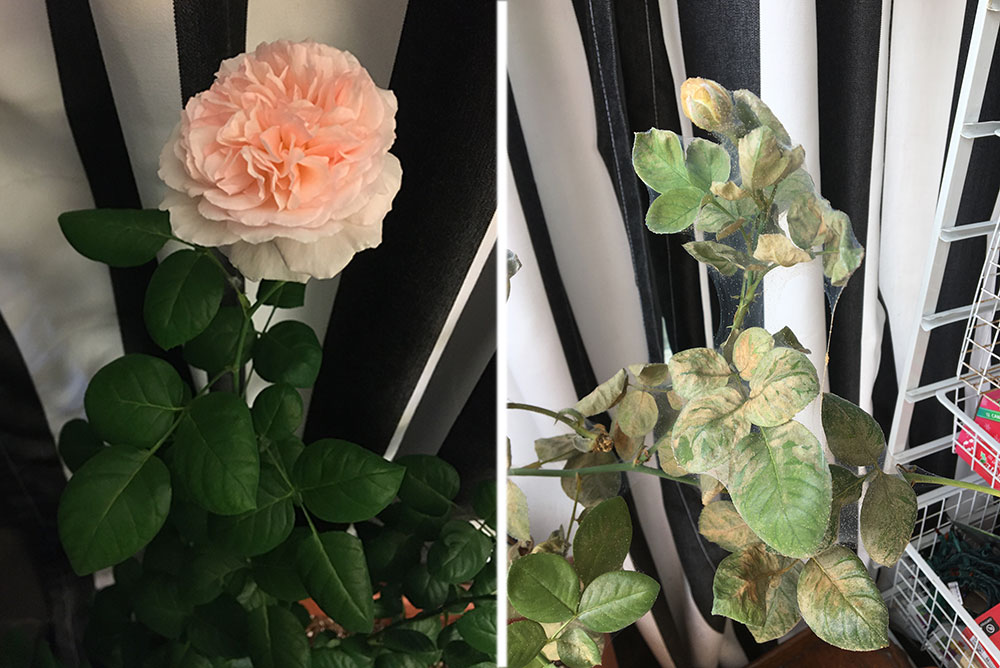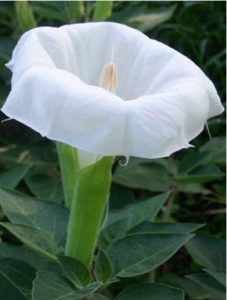
Tale of a rose: once so promising, now tragically compromised. / MyLittleBird photos.
WHY ANYONE would ask me questions about gardening, I don’t know. Have you noticed that I ditch any horticultural adventure that appears to be failing? Often, my best advice is for you to do so as well.
So I am startled to have received not one, not two, but three queries to respond to!
Dear “Stephanie Gardens”:
This spring I bought a Princesse Charlene de Monaco tea rose. I promptly planted the bare-root canes on my east-facing enclosed balcony, which I like to think of as my greenhouse, and the plant eventually rewarded me with two gorgeous roses. And then a few more started appearing. And then, and then . . . some of the leaves started to turn a weird mottled tan (I first thought it was too much sun), and soon what I’ve identified as spider mites had made webs around the buds and the surrounding leaves. They continue to spread. (I”m enclosing an admittedly lousy photo.)
My question: Should I cut the diseased branches off and try to rescue the main body of the plant, or should I toss the whole thing and chalk it up to learning?
Your friend in horticulture,
Flora Bunda
Dear Flora:
That is one helluva sad-looking rosa—which is Latin for rose.
Personally? I’d throw it out and buy another; you sure don’t want it around other plants in your greenhouse as the bloody bugs will just romp over to something else.
After an intense Internet search, I find that spider mites (Tetranychidae) are polyphagous herbivores, meaning they devour plants. That the name includes the word “mite” is misleading, referring only to the size of the bugs. They are arachnids, spiders, not mites, and just like their larger, hairier relatives have eight creepy legs. If that doesn’t make you itch to burn the plant I don’t know what will.
That said, the stems of your once-lovely rose look healthy and green, so you might prune it back hard, and then pray. That sometimes works for me. If, by chance, new leaves emerge and the mites reappear, you could try suffocating them with a spritz of dish detergent mixed with water. Or, if you insist on paying for something, try Safer Insecticidal Soap.
More-toxic remedies would be unwise in an enclosed area, like a greenhouse, unless you have it in for someone and can stay out of the house for an extended period. (See Question 3, below).
Dear “Stephanie Gardens”:
I love hearing about your clandestine plant-pinching. I think it would add bit of thrill to my morning walks around the neighborhood (and some fun to my boring container gardens), but I’m unsure what to look for.
Thank you for your inspiration!
Pilfering Poppy
Dear Poppy:
Well, technically you can pinch and propagate almost anything, but we’ll stick to the laziest possibilities, not the ones that require years of fretting and any tool beyond your fingers.

The Begonia Solenia in apricot. You can obtain one at Marde Ross & Company.
By the way, we do not call this “pilfering.” It’s pruning, a perfectly respectable activity. If someone catches you, say you were simply correcting an imbalance, or deadheading.
Generally, fat and juicy stems take most easily to the pinch-and-plant method of propagation. With such plants as begonias, coleus and tradescantia (wandering jew), you can go straight from nipping a stem just below a node (the little stem bump where a leaf or roots might emerge) to sticking it in a pot.
Other cuttings prefer to bathe before planting. Put gleaned clippings of plants such as pothos, impatiens and Christmas cactus in a glass of water. Roots should appear in about a week, and they can be transplanted to a pot or directly into the garden. Herbs such as mint, basil and lemon verbena also take well to water-rooting.
Geraniums are one outlier: Despite their firm stems, they are easily divided. Dip the stem in rooting hormone like Bonide, make a hole in the soil with a pencil, chopstick or finger, insert the stem, and water.
For more about easily propagated plants, check out this article on Gardening Know How.
Dear “Stephanie Gardens”:
I have several (single) friends who’ve taken up herb gardening as a twee new quarantine hobby. They’re drying the herbs, freezing them in oil, making boozy infusions, etc. Meanwhile, I’ve been contemplating murdering my husband, who is also stuck at home. My home. With me. Which got me thinking, what are some fun things to grow that I could also threaten him with when needed?
Love,
Lucretia
Dear Lucretia:
Were you thinking mildly ill, or bumping him off?

Angel’s Trumpet, or Datura, looks so pristine and benign, but beware: It’s poisonous. /
Some poisonous plants have been done to death, but with good reason: They get the job done. Most, however, can be diluted for degrees of discomfort and used in sauces and salad dressing, or as your friends do—in cocktails.
Whichever you choose, the plant should be lovely to look at, so you can flutter your eyelashes, clutch your bodice, and reasonably say—through tears, if you can manage—Officer! I had no idea. But this is not an acting course, it’s a gardening column.
Attractiveness eliminates Belladonna, also known as Deadly Nightshade. While it’s a legendary literary poison—think Macbeth—it’s not particularly attractive, with its no-account, itty-bitty bell-shaped flowers and innocuous-looking black berries. Really, everything about it is a dead giveaway.
Now for a clutch of quite captivating possibilities.
Datura is an old favorite. Also known as Angel’s Trumpet (as in, ha-ha you’re dead) and Devil’s Snare, this plant is gorgeous to behold, easy to grow and divinely lethal.

Petite Pink Oleander looks so innocent, and it’s lovely to grow, just don’t suck on one of its leaves. / Photo from Gardenia.net.
Hemlock has such a lovely retro vibe, doesn’t it? A member of the carrot family, it has frilly white flowers like my favorite weed, Queen Anne’s Lace. Less well known, but also in the carrot family, is Giant Hogweed, which can grow to 14 feet and just oozes toxic sap.
Yellow-flowering Wild Parsnip can bring on a nasty rash a couple of days after contact, meanwhile Foxglove with its towering flower-covered stalks can be, quite literally, heart-stopping, as can Mistletoe (Merry Christmas, darling!).
For a mild malaise, look to Bitter Nightshade, a rather pretty perennial with purple flowers and juicy-looking red berries (think pie), which can cause headache, vomiting and diarrhea.
But if I had to pick just one to do him in, I’d go with Oleander. There’s no messing about with this beauty, with its clusters of showy flowers in shades of red, pink and white. A single leaf can kill an adult.
Make sure his life insurance is paid up and have fun!
—Stephanie Cavanaugh
LittleBird “Stephanie Gardens” doesn’t have all the answers, but she’ll research some if you submit questions to her. You can just add a Comment to this post, and the question will be forwarded to our Green Acre columnist.
MyLittleBird often includes links to products we write about. Our editorial choices are made independently; nonetheless, a purchase made through such a link can sometimes result in MyLittleBird receiving a commission on the sale, whether through a retailer, an online store or Amazon.com.


Sempervivum means “live forever,” which makes this succulent perfect for those that don’t have a natural knack for rising.
Dear Stephanotis, I have rosemary, basil and mint plants on my balcony. It gets plenty sun. I water regularly. But they are all sluggish growers. They are limp and placid – not worth cutting to use (mainly to muddle in a cocktail). Is my mistake keeping them in small pots – or should I sink more cocktails to forget their stunted state. Thanks, Bouquet de Hyacinths.
Bird is not responsible for ads Jackie, or where they are placed. But whatever algorithm handles these things attempts to match the content with the ad – in this case to pretty funny effect. They keep switching them out too – so I haven’t seen that one. Thanks for enjoying! S
Very, very funny! Plenty of “didn’t know that” moments too. Found the Ad (man trimmer) most disconcerting – think that could be lethal also. Regards, Jackfruit. There really is such a thing I’m told.
Well… save it. Ya never know.
A laugh a sentence read. And, although I am not a gardener, very informative to boot. I just wish (to fit in with the style of this column) I’d been named Marigold….
Best one yet! A problem I don’t have to deal with, happily.